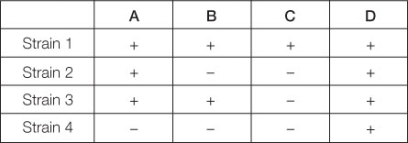Multiple Choice
Use the following to answer questions :
Suppose that a wild-type bacterium can synthesize substance D,but various mutant strains cannot.We know that substance D is synthesized from substance X in a pathway that involves three intermediate substances (A,B,and C) ,but we do not know the order of the steps in the pathway.Below is a table of four different mutant strains that have been tested for their ability to grow on the various substances.The plus sign means that the strain can grow on that substance;the negative sign means that the strain cannot grow on that substance. 
-Suppose that another strain (strain 5) can grow on substance B but cannot grow on substance C.What can we infer from this observation?
A) Strain 5 cannot grow on substance A.
B) Strain 5 cannot grow on substance D.
C) Strain 5 has a defect in the enzyme that converts substance B to substance C.
D) Strain 5 has a defect in the enzyme that converts substance B to substance D.
E) Strain 5 has a defect in the enzyme that converts substance C to substance B.
Correct Answer:

Verified
Correct Answer:
Verified
Q5: In eukaryotes,ribosomes become associated with endoplasmic reticulum
Q6: What is a ribozyme?<br>A) Any component of
Q7: Suppose you take glycine tRNA and modify
Q8: You have carried out a process of
Q9: The anticodon 3'-GCI-5'could not pair with<br>A) 5'-GCA-3'.<br>B)
Q11: An mRNA molecule with 360 codons has
Q12: Which type of molecule transfers information from
Q13: Which discovery caused the modification of the
Q14: Which change affects one and only one
Q15: Use the following to answer questions :<br>Suppose